To read the full report, please download PDF.
USD rebound extends at start of 2024
FX View:
The USD has continued to rebound over the past week as it reverses losses sustained at the end of last year. The USD has benefitted from the paring back of Fed rate cut expectations encouraged by Fed comments and the ongoing resilience of the US economy. The release of the latest US PCE deflator report for December in the week ahead should though provide further evidence that inflation is slowing back to the Fed’s target and laying the foundations for the Fed to begin cutting rates this year. At the same time, the USD is benefitting from ongoing investor concerns over weak growth outside of the US. In the week ahead, the BoC, BoJ, ECB and Norges Bank will provide policy updates. The BoC and ECB are expected to maintain relatively hawkish policy guidance that will disappoint market expectations for quicker rate cuts. In contrast, the BoJ is expected to maintain their dovish policy stance until they are more confident stronger wage growth will be sustained. A delayed exit from negative rates has already contributed to the JPY underperforming at the start of this year.
USD REBOUND HAS BEEN BROAD-BASED OVER PAST WEEK
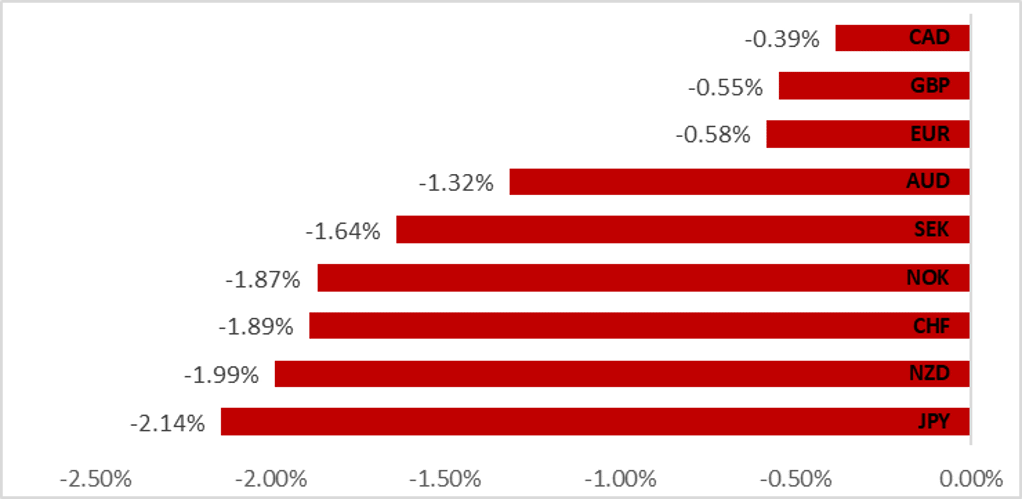
Source: Bloomberg, 13:10 GMT, 19th January 2024 (Weekly % Change vs. USD)
Trade Ideas:
We are recommending a new long USD/CHF trade idea. After strong gains at the end of last year, we expect the CHF to continue correcting lower at the start of this year encouraged by the recent pushback from the SNB.
FX Correlation Heatmaps:
G10 FX rates have been strongly correlated to global equity market performance over the past month. AUD/USD and USD/CAD have had the strongest correlations to developed market equity performance.
FX Views
USD: What’s driving the USD’s strong start to the new calendar year?
The USD continued to rebound at the start of new calendar year resulting in the dollar index rising back up towards resistance from the 200-day moving average that comes in just below 103.50. The USD has now almost fully reversed losses recorded in December after Fed Chair Powell stated that the Fed has started to discuss rate cuts at the 13th December FOMC meeting. So far this month the USD has strengthened the most against the JPY and the higher beta G10 currencies of the SEK, AUD, NOK, and NZD. It mainly marks a reversal of the price action from December when the NOK, JPY and SEK were the best performing G10 currencies.
There have been two fundamental drivers for the USD’s rebound at the start of this year. The first reason is that market participants’ have started to question just how quickly the Fed is likely to start cutting rates this year and then the pace of cuts once the easing cycle is underway. The March FOMC meeting is now judged as closer to a 50:50 call for the timing of the first Fed rate cut whereas it was judged as more of a done deal at the end of last year. The amount of expected Fed cuts by the end of this year has also been scaled back from around -160bps to closer to -140bps. The hawkish repricing of the Fed policy outlook at the start of this year has been encouraged both by comments this week from Fed Governor Waller and evidence that the US economy is continuing to prove resilient to higher rates.
Fed Governor Waller stated that he is becoming more confident in his outlook for a softer landing for the US economy. He wants to see further evidence that US inflation is moving back to the Fed’s 2.0% target in the coming months before cutting rates. He also indicated that he favours a more gradual pace of rate cuts once the easing cycle is underway based on the assumption that if the US economy achieves a softer landing he favours lowering rates in 25bp increments. The resilience of the US economy was again evident by stronger US retail sales for December. The report suggests that the slowdown for the US consumer and economy was more modest than expected in Q4. The release of the latest PCE deflator report in the week ahead for December will then be scrutinized to assess if it confirms that core inflation has been close the Fed’s target in the 2H of last year. The sharp slowdown in US inflation should encourage the Fed to make their policy rate less restrictive even if growth does not slow below trend.
USD WEAKNESS OVERSHOT SPREADS AT END OF 2023
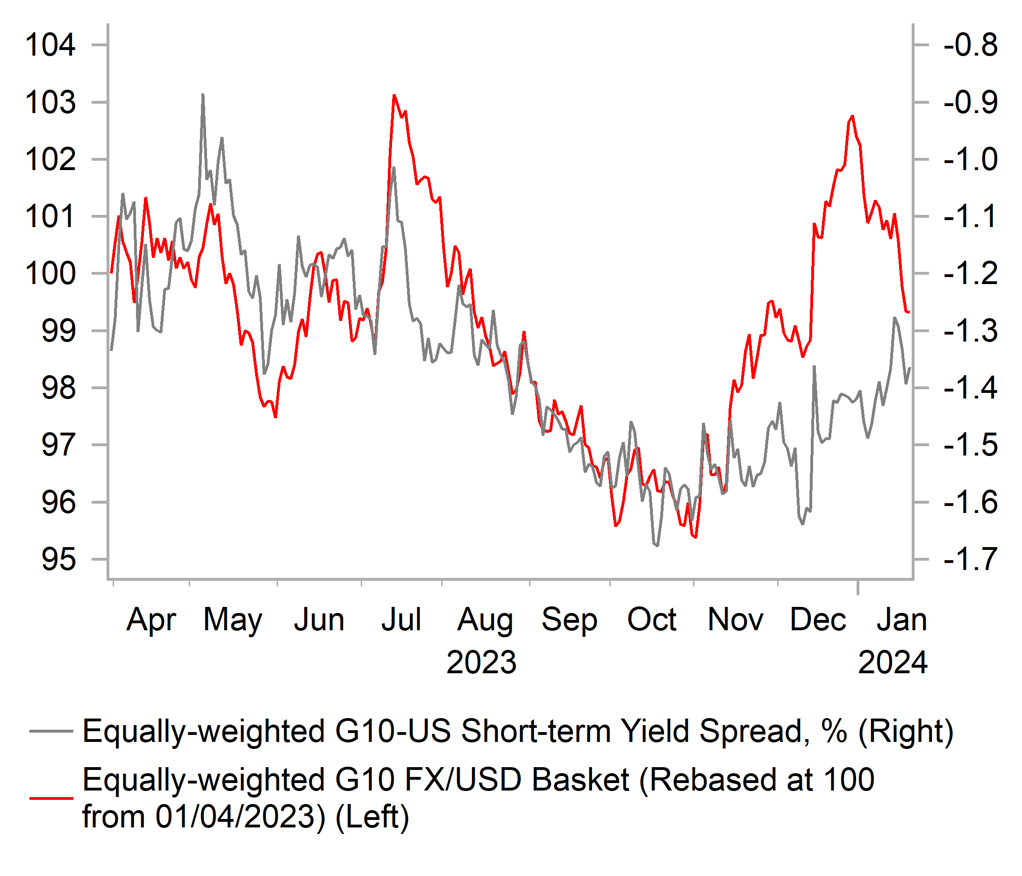
Source: Bloomberg, Macrobond & MUFG GMR
SHIFT TO BEARISH USD SPECULATIVE POSITIONING
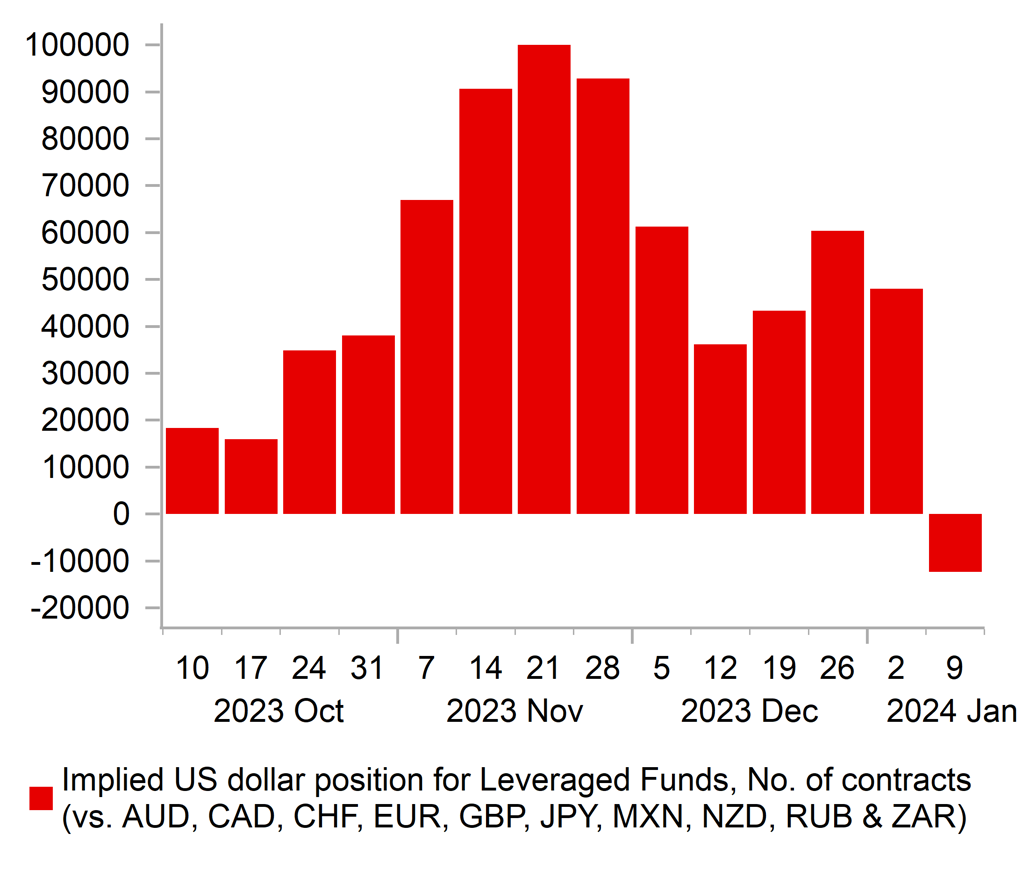
Source: Bloomberg, Macrobond & MUFG GMR
The second trigger for the USD rebound at the start of this year has been pick-up in concerns over slowing growth outside of the US. Economic data releases from Europe have remained weak at the end of last year highlighting the risk that both the euro-zone and UK economies may have fallen into a mild technical recessions in 2H of last year. The release today of the much weaker than expected UK retail sales report for December has dampened recent optimism that the UK economy avoided a second consecutive quarter of negative growth in Q4 after contracting by -0.1% in Q3. At the same time investor sentiment towards Chinese assets has deteriorated at the start of this year reflecting in part ongoing concerns over the health of China’s economy. The latest GDP report for Q4 and monthly activity data for December revealed that China’s economy lost upward momentum at the end of last year after picking up in Q3 in response to policy stimulus. It will keep pressure on domestic policymakers to provide further stimulus in the coming quarters to support growth. In light of the weak growth outlook Blomberg’s commodity price index (BCOM) has fallen back to last year’s lows providing a headwind for the performance of G10 commodity currencies of the AUD, CAD, NOK and NZD that have underperformed so far this month.
The USD’s rebound has been curtailed by the hawkish repricing of rates outside of the US despite weak growth concerns in those regions. ECB officials have presented a unified message in recent weeks by pushing back against premature rate cut expectations. They don’t appear overly concerned that the eurozone economy may have fallen into technical recession in the 2H of last year. President Lagarde surprisingly revealed with conviction that that the ECB already appears to have decided to cut rates by the summer indicating that the timing of the first cut is unlikely to be delivered until the June policy meeting at the earliest. Some of the more hawkish ECB officials have even been stated that a rate cut is unlikely in the 1H of this year. The ECB wants to see more evidence in the coming months that inflation risks in the euro-zone are continuing to ease including slower wage growth. The comments have increased the likelihood that the ECB will start cutting rates after the Fed. We expect the ECB to repeat that relatively hawkish message at next week’s policy meeting.
The rebound for the USD at the start of this year supports our view that the market got ahead of itself in pricing in a weaker USD at the end last year. In our Annual FX Outlook report (click here), we outlined our forecasts for a modest USD rebound in Q1. The main risks to that view in the week ahead include the release of the US PCE deflator report for December, and the BoJ’s upcoming policy meeting. However it appears highly unlikely now that the BoJ will exit negative rates next week (click here). We have pushed back the timing of the first BoJ rate hike until April.
WILL EZ INFLATION SLOWDOWN BE SUSTAINED?
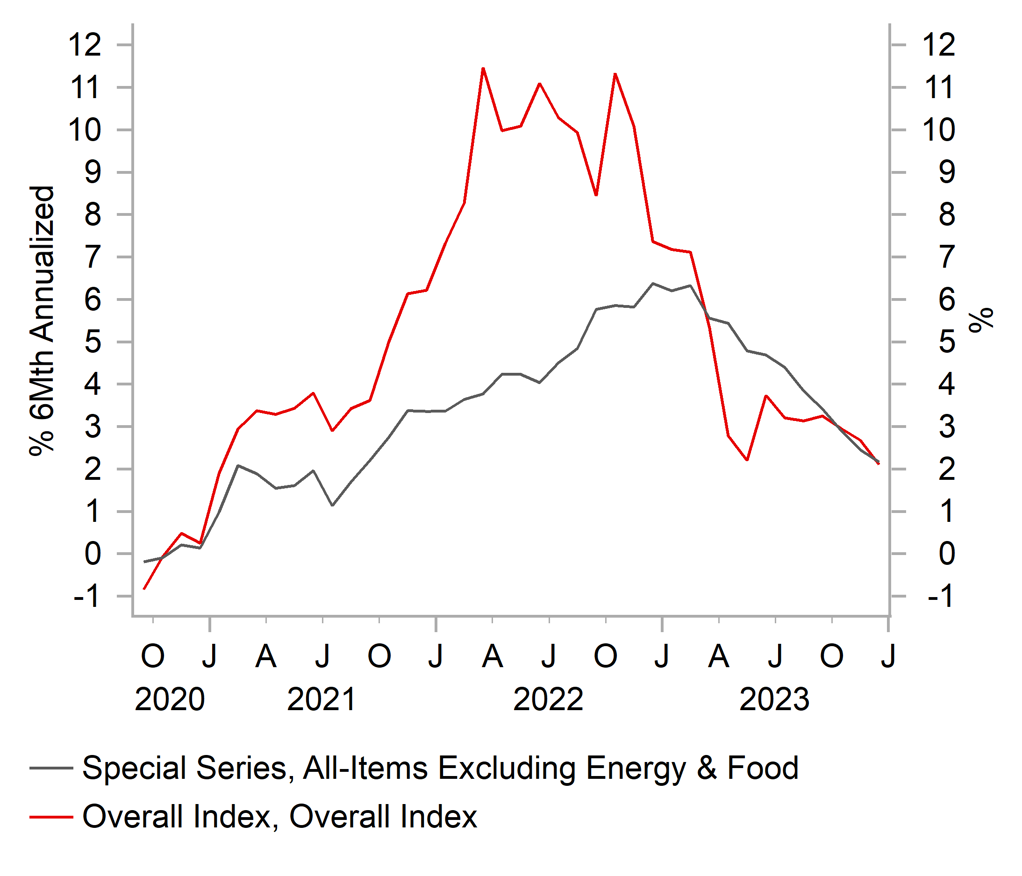
Source: Bloomberg, Macrobond & MUFG GMR
SETBACK FOR G1O COMMODITY FX
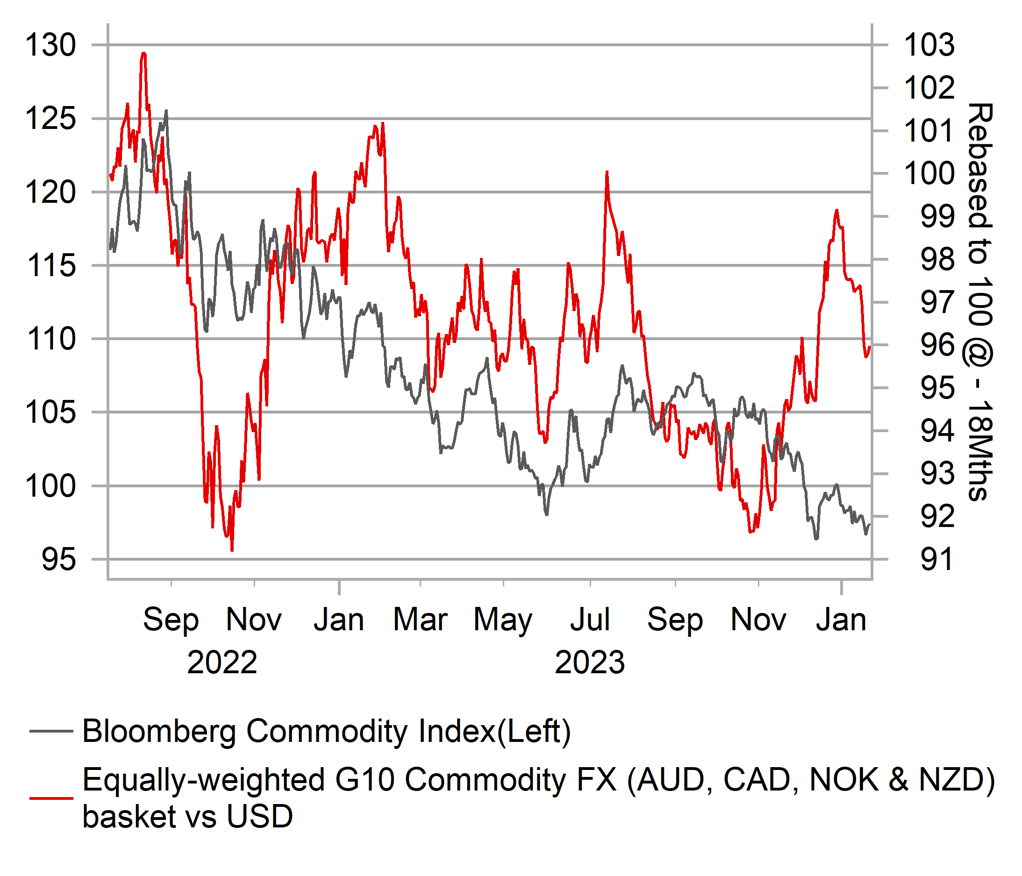
Source: Bloomberg, Macrobond & MUFG GMR
Weekly Calendar
|
Ccy |
Date |
BST |
Indicator/Event |
Period |
Consensus |
Previous |
Mkt Moving |
|
CHF |
01/22/2024 |
09:00 |
Total Sight Deposits CHF |
-- |
476.3b |
! |
|
|
USD |
01/22/2024 |
15:00 |
Leading Index |
Dec |
-0.3% |
-0.5% |
!! |
|
JPY |
01/23/2024 |
Tbc |
BOJ Policy Balance Rate |
-- |
-0.10% |
!!! |
|
|
GBP |
01/23/2024 |
07:00 |
Public Sector Net Borrowing |
Dec |
-- |
13.4b |
!! |
|
EUR |
01/23/2024 |
09:00 |
ECB Bank Lending Survey |
!! |
|||
|
NZD |
01/23/2024 |
21:45 |
CPI YoY |
4Q |
4.7% |
5.6% |
!!! |
|
JPY |
01/23/2024 |
23:50 |
Trade Balance |
Dec |
-¥122.1b |
-¥776.9b |
!! |
|
EUR |
01/24/2024 |
08:15 |
HCOB France Composite PMI |
Jan P |
-- |
44.8 |
!! |
|
EUR |
01/24/2024 |
08:30 |
HCOB Germany Composite PMI |
Jan P |
-- |
47.4 |
!! |
|
EUR |
01/24/2024 |
09:00 |
HCOB Eurozone Composite PMI |
Jan P |
-- |
47.6 |
!!! |
|
GBP |
01/24/2024 |
09:30 |
S&P Global UK Composite PMI |
Jan P |
-- |
52.1 |
!!! |
|
CAD |
01/24/2024 |
14:45 |
Bank of Canada Rate Decision |
5.00% |
5.00% |
!!! |
|
|
USD |
01/24/2024 |
14:45 |
S&P Global US Composite PMI |
Jan P |
-- |
50.9 |
!! |
|
NOK |
01/25/2024 |
09:00 |
Deposit Rates |
-- |
4.50% |
!!! |
|
|
EUR |
01/25/2024 |
09:00 |
Germany IFO Business Climate |
Jan |
-- |
86.4 |
!! |
|
EUR |
01/25/2024 |
13:15 |
ECB Deposit Facility Rate |
-- |
4.00% |
!!! |
|
|
USD |
01/25/2024 |
13:30 |
GDP Annualized QoQ |
4Q A |
1.8% |
4.9% |
!!! |
|
USD |
01/25/2024 |
13:30 |
Durable Goods Orders |
Dec P |
0.9% |
5.4% |
!! |
|
USD |
01/25/2024 |
13:30 |
Initial Jobless Claims |
-- |
-- |
!! |
|
|
EUR |
01/25/2024 |
13:45 |
ECB President Lagarde Press Conference |
!!! |
|||
|
USD |
01/25/2024 |
15:00 |
New Home Sales |
Dec |
650k |
590k |
!! |
|
JPY |
01/25/2024 |
23:30 |
Tokyo CPI YoY |
Jan |
2.0% |
2.4% |
!! |
|
SEK |
01/26/2024 |
07:00 |
Unemployment Rate SA |
Dec |
-- |
7.9% |
!! |
|
EUR |
01/26/2024 |
09:00 |
M3 Money Supply YoY |
Dec |
-- |
-0.9% |
!! |
|
USD |
01/26/2024 |
13:30 |
PCE Deflator YoY |
Dec |
2.6% |
2.6% |
!!! |
Source: Bloomberg, Macrobond & MUFG GMR
-
Key Events:
- The BoJ, BoC, Norges Bank and the ECB will hold their fist policy meetings of 2024 in the week ahead. It has become much less likely that he BoJ will announce an exit from negative rates and/or YCC at their upcoming policy meeting. Governor Ueda has signaled that there is unlikely to be sufficient new information to justify such an important policy shift as soon as next week. The recent earthquake has created additional uncertainty which argues against short-term policy changes. The comments from Governor Ueda at the upcoming press conference will be scrutinized closely to see if he provides any fresh guidance over the potential timing of the first hike. We are now expecting the BoJ to exit negative rates in April.
- The BoC is expected to leave their policy rate on hold in the week ahead and refrain from signaling that a rate cut is imminent. The BoC wants to see a further sustained easing in core inflation but it has ticked higher at the end of last year. We expect the BoC to begin cutting rates in Q2 after inflation slows further supported by weak economic growth in Canada.
- The ECB is expected to leave rates on hold in week ahead. Policymakers have been busy outlining their views on monetary policy ahead of the upcoming meeting. There has been a strong unified message that the euro-zone rate market has gotten ahead of itself by pricing in rate cuts at the start of this year. President Lagarde sent a clear signal that they plan to cut rates by the summer indicating that the timing of the first cut is most likely to be at the June meeting at the earliest point.
- The main economic data releases in the week ahead will be from the US. The release of the GDP report for Q4 is expected to reveal that the US economy slowed after unsustainably robust growth in Q3. However, it appears that the US economy is continuing to prove more resilient than expected at the end of last year. Even as growth has held up better than expected, inflation has slowed back to the Fed’s target boosting optimism over a softer landing for the US economy. The PCE deflator report for December is expected to confirm that core inflation slowed back to the Fed’s 2.0% target in 2H of last year which is providing encouragement for the Fed to begin cutting rates this year.

